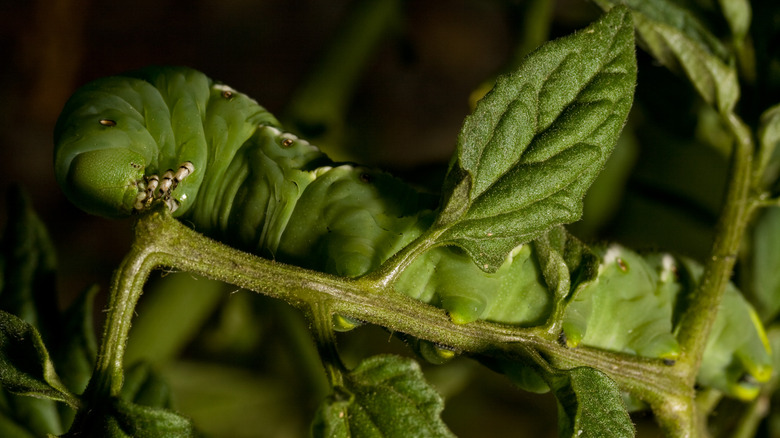This Type Of Hummingbird Moth Causes Serious Issues For Your Tomatoes
A number of things can stand in the way when it comes to you growing the best tomatoes in your garden, including not providing enough sun, not watering frequently enough, disease, and pests. One such pest you'll want to keep an eye on is called a sphinx or hawk moth. This bug is a type of hummingbird moth that may be targeting your tomato plants. The winged insect hums like a hummingbird, sips nectar, and can suspend in the air, but don't let it fool you into mistaking it for a hummingbird. This moth spells trouble for your tomato patch because it's actually the mature version of the tomato hornworm, and it's responsible for laying the eggs from which baby tomato hornworms hatch.
While the moth is beneficial as a pollinator, its offspring will wreak havoc on your tomato plants. Tomato hornworms are heavy feeders that chew up the tomato's foliage and eat their way through the fruit. The larger the caterpillars get, the more damage they create. Therefore, it's important to identify the moth's eggs and larvae so you can eliminate them from your tomato patch. Meanwhile, you can prevent these hummingbird moths from laying eggs on your tomatoes with the help of companion plants and other prevention methods.
How to identify sphinx moth offspring and what to do about them
The nocturnal nature of sphinx moths makes it challenging to manage their residence among your tomatoes. They feed on flowers in the nighttime and female moths deposit their eggs on the plant in the evening. As many as 1,000 eggs can be laid. It's crucial to learn to spot the eggs as soon as possible so you can remove the eggs before they hatch or before young caterpillars become the dreaded, full-grown tomato hornworm.
Eggs are sphere shaped and pale green. Adult moths typically lay them in late spring. Their tiny, 1.5-millimeter diameter is easier to see with close inspection. You will notice the eggs laying on the top of or undersides of older foliage. The eggs may hatch just three days after they're laid, so it's key to spot them quickly. When you do, you can rub them off the leaf of the plant.
However, if you don't get rid of the eggs before they hatch, you can remove the hornworms by hand and drop them in soapy water. Alternatively, an application of a natural bacterial insecticide called Bacillus thuringiensis (BT) when caterpillars are young can wipe them out before they create significant damage. The kurstaki strain specifically (BTK) is effective on tomato hornworms in the larva stage. The insecticide can be found in dust or liquid form. However, while BTK doesn't harm beneficial insects, it can kill caterpillars from butterflies if they ingest it.
How to keep sphinx moths away from tomato plants in the first place
The best way to nip the production of tomato hornworms on your tomato plants is to prevent the female sphinx moth from laying eggs on them in the first place. While some suggest using zap lights to lure the moths and zap them with electricity, this is obviously not a humane way of getting them out of your garden. Remember, sphinx moths themselves can be a supportive pollinator for your garden, and vilifying them because of the damage caused by their offspring may not be the answer.
One solution to keep your tomatoes safe without harming the moths is to place a protective covering over your tomato plants before the moths can lay their eggs in the spring. Installing garden hoops, tunnels, and row covers are a few options to keep these winged bugs off your tomato plants. You can also take advantage of companion planting to repel the sphinx moth. Basil, dill, marigolds, and chamomile are some companion plants you should grow next to tomatoes in your garden. They are believed to repel sphinx moths because of their strong odors, which the insects loathe. At the same time, you can include yarrow or small asters to attract wasps that will lay eggs on the tomato hornworms you don't get to, eventually killing them.


